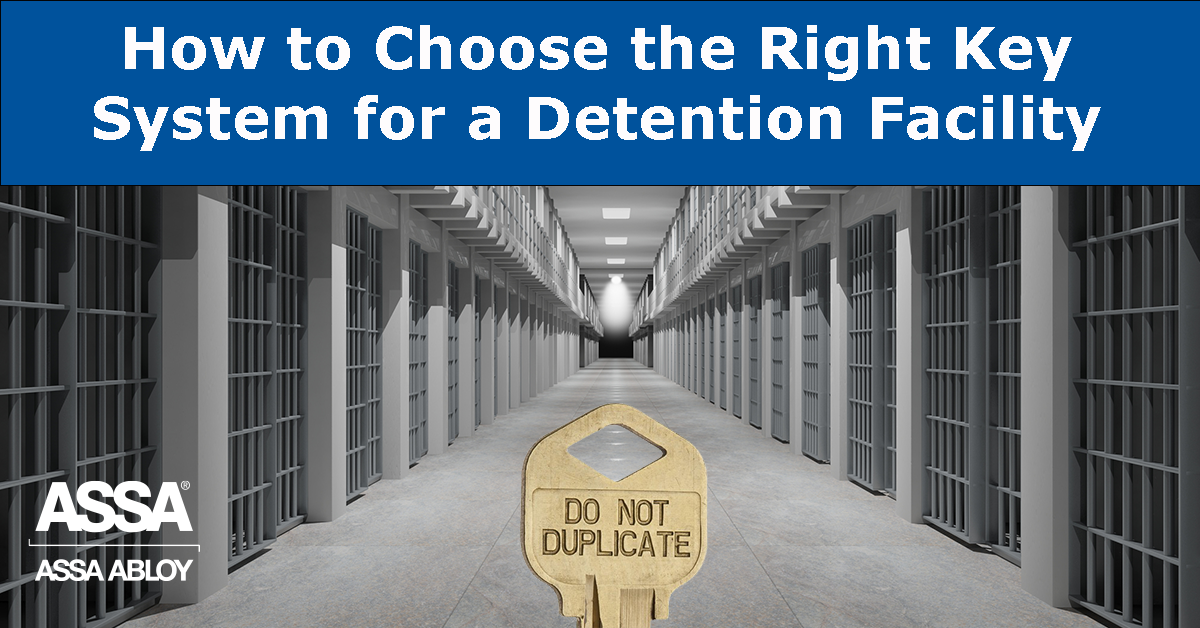How to Choose the Right Key System for a Detention Facility
Is it time for a new key system? Rekeying a detention center might feel daunting, but there are several steps that will smooth the process.

Is it time for a new key system? Rekeying a detention center might feel daunting, but there are several steps that will smooth the process. It’s important to understand the reasons behind a key system upgrade, complete a site survey, and outline security objectives. This level of due diligence will allow you to select a key system that fulfills all criteria.
5 signs to upgrade key systems
It may take a deliberate assessment to uncover that your existing key system is no longer sufficient for your prison or jail. There aren’t always telltale signs that it’s time for an update, so use these clues to dig deeper.
1) Inspections
A standard facility walkthrough is often too comprehensive to flag issues with keys, but a security assessment is an ideal method. Because this evaluation focuses exclusively on risk and vulnerabilities, access control is a top priority.
Updating the door schedule or performing preventive upkeep is also a good way to reveal disparities in the key system. These tasks require direct interaction with each lock and key, so it’s the perfect moment to think about the big picture.
2) Security compromises
Did you know the phrase “do not duplicate” on a key doesn’t have any legal weight? It’s only a visual deterrent, which means locksmiths or key machines can ignore the label. Only keys that are patent protected prevent unauthorized key duplication. This is because they have sanctions that mirror copyright law violations.
Even if your facility uses patented keys, be mindful that the patent eventually expires. Patents aren’t indefinite, lasting around 20 years in the U.S., and then anyone can produce products using that design. Many correctional institutions don’t want to accept the risk of duplication, no matter how remote.
It’s also possible a breach – unauthorized access or theft – will trigger a system replacement. New locks and keys are a sensible way to refortify the detention facility, especially if a break-in was facilitated by a stolen key that can’t be recovered. It’s the only way to ensure old keys are rendered inactive.
3) Poor key policies
Has key control been lax over the years? This creates myriad issues: keys issued to the wrong individuals, unenforced key return practices, and incomplete records. Rekeying will rectify poor inventory management no matter the cause.
4) Exhausted expansion
If your facility is increasing its footprint, review how much expansion your master key system has left. Because there is a limited number of unique cut combinations on a mechanical key, there is a finite number of total openings it can serve. If the expansion ceiling has been reached, reusing a cut combination creates a security risk.
5) Disparate systems
Is your staff carrying enormous key rings? This symbolizes a common problem – separate keys for separate areas. It’s not efficient for personnel who move frequently between different areas to juggle multiple keys. This is further compounded if they have to spend time going to a key cabinet several times a day.
Read more about the importance of unifying your master key system in our post Strengthen Your Detention Facility with a Master Key System.
Conduct with a Site Survey
Before selecting a new key system, have an accurate accounting of all secured openings. The audit goes beyond the primary doors – gates, lockers, stairwells, roof access, and mechanical rooms are included as well. This is also a smart time to review the naming conventions of the key hierarchy, ensuring abbreviations, acronyms, and symbols are consistent.
The site survey can then be leveraged into a hardware schedule, which includes detailed product specifications. This information is the basis for scheduled maintenance and orders, which is typically coordinated by key tracking software or as a function under a CMMS (computerized maintenance management system).
It’s also critical to review key permissions. It’s possible staff turnover, promotions, or changes in job scope may have shifted over time, altering what authorization is appropriate. Verify that everyone has the correct level of access and a matching key.
All three legs of the site survey – inventory, records, and permissions – are need to set up any new key system for long-lasting success.
Outline your security objectives
The final question to ask is “what should a new key system accomplish?” Establish measurable and specific security goals. It’s like starting a construction project by articulating what the building’s purpose is. A clear starting point will ensure your master key system delivers the correct outcome.
This groundwork makes it easier to evaluate product specifics, such as standards (compliance with UL 437 high security and ASTM 1577 detention lock standards), features (attack resistance), and capabilities (retrofit compatible). These efforts made in the beginning phases of a rekey project will go a long way to extend the life of the new system.
ASSA can help!
Let ASSA guide you through the process of selecting a new key system, from the discovery process to the post-installment assessment. We also offer training to service personnel on rekeying and maintaining cylinders, including warranty questions.
For more information, please fill out the form below.